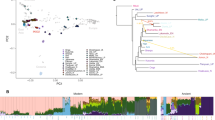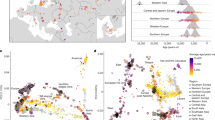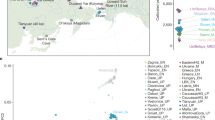Abstract
Populations genetically related to present-day Europeans first appeared in Europe at some point after 38,000–40,000 years ago, following a cold period of severe climatic disruption. These new migrants would eventually replace the pre-existing modern human ancestries in Europe, but initial interactions between these groups are unclear due to the lack of genomic evidence from the earliest periods of the migration. Here we describe the genomes of two 36,000–37,000-year-old individuals from Buran-Kaya III in Crimea as belonging to this newer migration. Both genomes share the highest similarity to Gravettian-associated individuals found several thousand years later in southwestern Europe. These genomes also revealed that the population turnover in Europe after 40,000 years ago was accompanied by admixture with pre-existing modern human populations. European ancestry before 40,000 years ago persisted not only at Buran-Kaya III but is also found in later Gravettian-associated populations of western Europe and Mesolithic Caucasus populations.
This is a preview of subscription content, access via your institution
Access options
Access Nature and 54 other Nature Portfolio journals
Get Nature+, our best-value online-access subscription
$29.99 / 30 days
cancel any time
Subscribe to this journal
Receive 12 digital issues and online access to articles
$119.00 per year
only $9.92 per issue
Buy this article
- Purchase on Springer Link
- Instant access to full article PDF
Prices may be subject to local taxes which are calculated during checkout




Similar content being viewed by others
Data availability
Sequence data generated in this study are available through the EBI Sequence Read Archive PRJEB64496. The mitochondrial sequences are available through GenBank (accession number MK934322 and OR327029).
Code availability
No new code and sequence analysis methods were developed. Details on the analysis settings are provided in Methods section.
Change history
22 January 2024
A Correction to this paper has been published: https://doi.org/10.1038/s41559-024-02332-9
References
Hajdinjak, M. et al. Initial upper palaeolithic humans in europe had recent neanderthal ancestry. Nature 592, 253–257 (2021).
Slimak, L. et al. Modern human incursion into Neanderthal territories 54,000 years ago at Mandrin, France. Sci. Adv. 8, eabj9496 (2022).
Fu, Q. et al. The genetic history of Ice Age Europe. Nature 534, 200–205 (2016).
Prüfer, K. et al. A genome sequence from a modern human skull over 45,000 years old from Zlatý kůň in Czechia. Nat. Ecol. Evol. 5, 820–825 (2021).
Vallini, L. et al. Genetics and material culture support repeated expansions into Paleolithic Eurasia from a population hub out of Africa. Genome Biol. Evol. 14, evac045 (2022).
Fu, Q. et al. An early modern human from Romania with a recent Neanderthal ancestor. Nature 524, 216–219 (2015).
Giaccio, B., Hajdas, I., Isaia, R., Deino, A. & Nomade, S. High-precision 14C and 40Ar/39Ar dating of the Campanian Ignimbrite (Y-5) reconciles the time-scales of climatic-cultural processes at 40 ka. Sci. Rep. 7, 45940 (2017).
Fedele, F. et al. in Living Under the Shadow: Cultural Impacts of Volcanic Eruptions (eds Grattan, J. & Torrence, R.) Ch. 2 (Left Coast Press, 2007).
Fitzsimmons, K. E., Hambach, U., Veres, D. & Iovita, R. The Campanian Ignimbrite eruption: new data on volcanic ash dispersal and its potential impact on human evolution. PLoS ONE 8, e65839 (2013).
Black, B. A., Neely, R. R. & Manga, M. Campanian Ignimbrite volcanism, climate, and the final decline of the Neanderthals. Geology 43, 411–414 (2015).
Heinrich, H. Origin and consequences of cyclic ice rafting in the northeast Atlantic Ocean during the past 130,000 years. Quat. Res. 29, 142–152 (1988).
Zilhão, J. Neandertals and moderns mixed, and it matters. Evol. Anthropol. 15, 183–195 (2006).
Seguin-Orlando, A. et al. Genomic structure in Europeans dating back at least 36,200 years. Science 346, 1113–1118 (2014).
Sikora, M. et al. Ancient genomes show social and reproductive behavior of early Upper Paleolithic foragers. Science 358, 659–662 (2017).
Posth, C. et al. Palaeogenomics of Upper Palaeolithic to Neolithic European hunter-gatherers. Nature 615, 117–126 (2023).
Prat, S. et al. The oldest anatomically modern humans from far southeast Europe: direct dating, culture and behavior. PLoS ONE 6, e20834 (2011).
Péan, S. et al. The Middle to Upper Paleolithic Sequence of Buran-Kaya III (Crimea, Ukraine): new stratigraphic, paleoenvironmental, and chronological results. Radiocarbon 55, 1454–1469 (2013).
Yanevich, A. Les occupations gravettiennes de Buran-Kaya III (Crimée): contexte archéologique. L’Anthropologie 118, 554–566 (2014).
Prat, S. et al. The first anatomically modern humans from south-eastern Europe. Contributions from the Buran-Kaya III Site (Crimea). Bull. Mém. Soc. Anthropol. Paris https://doi.org/10.3166/bmsap-2018-0032 (2018).
Hublin, J.-J. The modern human colonization of western Eurasia: when and where? Quat. Sci. Rev. 118, 194–210 (2015).
Reynolds, N. & Green, C. Spatiotemporal modelling of radiocarbon dates using linear regression does not indicate a vector of demic dispersal associated with the earliest Gravettian assemblages in Europe. J. Archaeol. Sci. Rep. 27, 101958 (2019).
Reynolds, N. in Culture History and Convergent Evolution (ed. Groucutt, H. S.) 187–212 (Springer, 2020).
Reynolds, N. in Les Sociétés Gravettiennes du Nord-Ouest Européen: Nouveaux Sites, Nouvelles Données, Nouvelles Lectures (eds Touzé, O. et al.) 309–321 (Presses Universitaires de Liège, 2021).
Demidenko, Y. E. in Encyclopedia of Global Archaeology (ed. Smith, C.) 1782–1791 (Springer, 2014).
Cullen, V. L. et al. A revised AMS and tephra chronology for the Late Middle to Early Upper Paleolithic occupations of Ortvale Klde, Republic of Georgia. J. Hum. Evol. 151, 102908 (2021).
Golovanova, L. V. et al. The Early Upper Paleolithic in the northern Caucasus (new data from Mezmaiskaya Cave, 1997 excavation). Eurasian Prehistory 4, 43–78 (2012).
Bar-Yosef, O. et al. Dzudzuana: an Upper Palaeolithic cave site in the Caucasus foothills (Georgia). Antiquity 85, 331–349 (2011).
Hoffecker, J. F. A New Framework for the Upper Paleolithic of Eastern Europe (INSTAAR, 2022); https://instaar.colorado.edu/uploads/research/projects/kostenki/hoffecker-ESHE-2012-a-new-framework.pdf
Hoffecker, J. F. & Holliday, V. T. in The Upper Paleolithic of Northern Eurasia and America: Sites, Cultures, Traditions (eds Vasil’ev, S. A. & Tkach, E. S.) 140–158 (Russian Academy of Sciences, 2014).
Svoboda, J. A. The Gravettian on the Middle Danube. PALEO Rev. Archéol. Préhistorique 19, 203–220 (2007).
Hoffecker, J. F. The Early Upper Paleolithic of Eastern Europe reconsidered. Evol. Anthropol. Issues N. Rev. 20, 24–39 (2011).
Korlević, P. et al. Reducing microbial and human contamination in DNA extractions from ancient bones and teeth. BioTechniques 59, 87–93 (2015).
Glocke, I. & Meyer, M. Extending the spectrum of DNA sequences retrieved from ancient bones and teeth. Genome Res. 27, 1230–1237 (2017).
Renaud, G., Slon, V., Duggan, A. T. & Kelso, J. Schmutzi: estimation of contamination and endogenous mitochondrial consensus calling for ancient DNA. Genome Biol. 16, 224 (2015).
Weissensteiner, H. et al. Contamination detection in sequencing studies using the mitochondrial phylogeny. Genome Res. 31, 309–316 (2021).
Skoglund, P., Storå, J., Götherström, A. & Jakobsson, M. Accurate sex identification of ancient human remains using DNA shotgun sequencing. J. Archaeol. Sci. 40, 4477–4482 (2013).
Brunel, S. et al. Ancient genomes from present-day France unveil 7,000 years of its demographic history. Proc. Natl Acad. Sci. USA 117, 12791–12798 (2020).
Svensson, E. et al. Genome of peştera muierii skull shows high diversity and low mutational load in pre-glacial Europe. Curr. Biol. 31, 2973–2983.e9 (2021).
Hublin, J.-J. et al. Initial Upper Palaeolithic Homo sapiens from Bacho Kiro Cave, Bulgaria. Nature 581, 299–302 (2020).
Lazaridis, I. et al. Genomic insights into the origin of farming in the ancient Near East. Nature 536, 419–424 (2016).
Higham, T. et al. The timing and spatiotemporal patterning of Neanderthal disappearance. Nature 512, 306–309 (2014).
Petr, M., Pääbo, S., Kelso, J. & Vernot, B. Limits of long-term selection against Neandertal introgression. Proc. Natl Acad. Sci. USA 116, 1639–1644 (2019).
Bergström, A. et al. Insights into human genetic variation and population history from 929 diverse genomes. Science 367, eaay5012 (2020).
Fu, Q. et al. DNA analysis of an early modern human from Tianyuan Cave, China. Proc. Natl Acad. Sci. USA 110, 2223–2227 (2013).
Teschler-Nicola, M. et al. Ancient DNA reveals monozygotic newborn twins from the Upper Palaeolithic. Commun. Biol. 3, 650 (2020).
Jones, E. R. et al. Upper Palaeolithic genomes reveal deep roots of modern Eurasians. Nat. Commun. 6, 8912 (2015).
Jeong, C. et al. The genetic history of admixture across inner Eurasia. Nat. Ecol. Evol. 3, 966–976 (2019).
Lazaridis, I. et al. Paleolithic DNA from the Caucasus reveals core of West Eurasian ancestry. Preprint at bioRxiv https://doi.org/10.1101/423079 (2018).
Allentoft, M. E. et al. Population genomics of Stone Age Eurasia. Preprint at bioRxiv https://doi.org/10.1101/2022.05.04.490594 (2022).
Marín-Arroyo, A. B., Terlato, G., Vidal-Cordasco, M. & Peresani, M. Subsistence of early anatomically modern humans in Europe as evidenced in the Protoaurignacian occupations of Fumane Cave, Italy. Sci. Rep. 13, 3788 (2023).
Fedele, F. G., Giaccio, B., Isaia, R. & Orsi, G. in Volcanism and the Earth’s Atmosphere (eds Robock, A. & Oppenheimer, C.) 301–325 (American Geophysical Union, 2003).
Hoffecker, J. F. Desolate Landscapes: Ice-Age Settlement in Eastern Europe (Rutgers Univ. Press, 2002).
Marti, A., Folch, A., Costa, A. & Engwell, S. Reconstructing the Plinian and co-Ignimbrite sources of large volcanic eruptions: a novel approach for the Campanian Ignimbrite. Sci. Rep. 6, 21220 (2016).
Reimer, P. J. et al. The IntCal20 northern hemisphere radiocarbon age calibration curve (0–55 cal kbp). Radiocarbon 62, 725–757 (2020).
Bennett, E. A. et al. Library construction for ancient genomics: single strand or double strand? BioTechniques 56, 289–298 (2014).
Gansauge, M.-T. et al. Single-stranded DNA library preparation from highly degraded DNA using T4 DNA ligase. Nucleic Acids Res. 45, e79 (2017).
Gansauge, M.-T. & Meyer, M. Single-stranded DNA library preparation for the sequencing of ancient or damaged DNA. Nat. Protoc. 8, 737–748 (2013).
Massilani, D. et al. Past climate changes, population dynamics and the origin of bison in Europe. BMC Biol. 14, 93 (2016).
Renaud, G., Stenzel, U. & Kelso, J. LeeHom: adaptor trimming and merging for Illumina sequencing reads. Nucleic Acids Res. 42, e141 (2014).
Li, H. & Durbin, R. Fast and accurate short read alignment with Burrows–Wheeler transform. Bioinformatics 25, 1754–1760 (2009).
van der Valk, T. et al. Million-year-old DNA sheds light on the genomic history of mammoths. Nature 591, 265–269 (2021).
Li, H. et al. The sequence alignment/Map format and SAMtools. Bioinformatics 25, 2078–2079 (2009).
de Filippo, C., Meyer, M. & Prüfer, K. Quantifying and reducing spurious alignments for the analysis of ultra-short ancient DNA sequences. BMC Biol. 16, 121 (2018).
Jónsson, H., Ginolhac, A., Schubert, M., Johnson, P. L. F. & Orlando, L. mapDamage2.0: fast approximate Bayesian estimates of ancient DNA damage parameters. Bioinformatics 29, 1682–1684 (2013).
Okonechnikov, K., Conesa, A. & García-Alcalde, F. Qualimap 2: advanced multi-sample quality control for high-throughput sequencing data. Bioinformatics https://doi.org/10.1093/bioinformatics/btv566 (2015).
Weissensteiner, H. et al. HaploGrep 2: mitochondrial haplogroup classification in the era of high-throughput sequencing. Nucleic Acids Res. 44, W58–W63 (2016).
Huelsenbeck, J. P. & Ronquist, F. MRBAYES: Bayesian inference of phylogenetic trees. Bioinformatics 17, 754–755 (2001).
Darriba, D., Taboada, G. L., Doallo, R. & Posada, D. jModelTest 2: more models, new heuristics and parallel computing. Nat. Methods 9, 772 (2012).
Martiniano, R., De Sanctis, B., Hallast, P. & Durbin, R. Placing ancient DNA sequences into reference phylogenies. Mol. Biol. Evol. 39, msac017 (2022).
Quinlan, A. R. & Hall, I. M. BEDTools: a flexible suite of utilities for comparing genomic features. Bioinformatics 26, 841–842 (2010).
McKenna, A. et al. The genome analysis toolkit: a MapReduce framework for analyzing next-generation DNA sequencing data. Genome Res. 20, 1297–1303 (2010).
Rohland, N. et al. Three assays for in-solution enrichment of ancient human DNA at more than a million SNPs. Genome Res. 32, 2068–2078 (2022).
Danecek, P. et al. Twelve years of SAMtools and BCFtools. GigaScience 10, giab008 (2021).
Patterson, N. et al. Ancient admixture in human history. Genetics 192, 1065–1093 (2012).
Maier, R., Flegontov, P., Flegontova, O., Changmai, P. & Reich, D. On the limits of fitting complex models of population history to genetic data. eLife 12, e85492 (2023).
Kahle, D. & Wickham, H. ggmap: spatial visualization with ggplot2. R J. 5, 144–161 (2013).
Stamen. Stamen map tiles. maps.stamen.com http://maps.stamen.com/#terrain/12/37.7706/-122.3782 (accessed 20 July 2022).
Petr, M., Pääbo, S., Kelso, J. & Vernot, B. The limits of long-term selection against Neandertal introgression. Proc. Natl Acad. Sci. USA 116, 1639–1644 (2019).
Acknowledgements
The palaeogenomic facility of the Institut Jacques Monod obtained support from the University Paris Diderot within the programme ‘Actions de recherches structurantes’. The sequencing facility of the Institut Jacques Monod, Paris, is supported by grants from the University Paris Diderot, the Fondation pour la Recherche Médicale (DGE20111123014) and the Région Ile-de-France (11015901). Moreover, we acknowledge support from the French national research centre CNRS and EUR G.E.N.E. (ANR-17-EURE-0013; IdEx #ANR-18-IDEX-0001 l’Université de Paris; Programme d’Investissements d’Avenir) for supporting the PhD fellowship extension of O.P. We thank the National Academy of Sciences of Ukraine for permission to excavate at Buran-Kaya III and all the team members of the excavations. We also thank the French National Research Agency (ANR-05-JCJC-0240-01), the Fyssen Foundation, the Muséum national d’Histoire naturelle and the Centre National de la Recherche Scientifique (CNRS) for their financial support (excavations and anthropological analyses). We thank O. Gorgé for assistance with some of the sequencing.
Author information
Authors and Affiliations
Contributions
E.-M.G., S. Prat and S. Péan initiated the project. E.-M.G. and T.G. supervised the study. E.A.B., E.-M.G. and T.G. produced data. O.P. and E.A.B. performed formal analyses. O.P., E.A.B., T.G. and E.-M.G. interpreted the data. S. Prat, S. Péan, L.C. and A.Y. provided samples and information to the archaeological context. E.A.B. wrote the paper with input from all authors.
Corresponding authors
Ethics declarations
Competing interests
The authors declare no competing interests.
Peer review
Peer review information
Nature Ecology & Evolution thanks Martin Sikora and the other, anonymous, reviewer(s) for their contribution to the peer review of this work. Peer reviewer reports are available.
Additional information
Publisher’s note Springer Nature remains neutral with regard to jurisdictional claims in published maps and institutional affiliations.
Extended data
Extended Data Fig. 1 Recalibration of comparative AMS 14C dates of Buran-Kaya III.
Buran-Kaya III (BuKa3) layers 6-1 and 6-2 with Upper Palaeolithic samples. All dates were calibrated using the software OxCal v4.4.4 based on the IntCal20 calibration data set. Climatic events are represented by the orange band, the Campanian Ignimbrite (CI) volcanic super-eruption event by the darker orange band, the Heinrich Event 4 by the lighter orange band.
Extended Data Fig. 2 Bayesian phylogenetic tree of mitochondrial sequences.
Excluding Hyper-Variable Regions, from Early and Mid-Upper Palaeolithic individuals including those from Buran-Kaya III (red). Posterior probability indicated at the nodes. Scale bar denotes substitutions per site. Sources for mitochondrial sequences are listed in Supplementary Table 3. Additional ancient and canonical N sequences are included to give branching details. Inset gives detailed mutation information from mtphyl v.5.003 (https://sites.google.com/site/mtphyl/home) for both BuKa3 individuals. References for mitochondrial sequences are given in Supplementary Table 11.
Extended Data Fig. 3 Neanderthal ancestry calculated for ancient individuals.
Neanderthal ancestry calculated using direct f4-ratio test78. α values calculated in the form of (Vindija33.19, Chimp; test, Mbuti)/(Vindija33.19, Chimp; Chagyrskaya, Mbuti). The error bars represent ±1 standard error, which were calculated using weighted block jackknife and a block size of 5 Mb.
Extended Data Fig. 4 Genetic affinities between Buran-Kaya III and present-day populations.
Heatmap showing the shared genetic drift calculated by f3-statistics in the form of f3(Mbuti; BuKa3, modern). Higher f3 values indicate greater allele sharing between Buran-Kaya III (BuKa3) and populations from the HGDP dataset. The left half of the circles shows f3 values tested with BuKa3C while the right side show those tested with BuKa3A. The map was created with ggmap76 using Stamen Design map tiles.
Extended Data Fig. 6 Summary of f4 statistics involving BuKa3 and pre-CI genomes.
A. Results of f4(Mbuti, pre-CI; BuKa3, pre-CI) B. Results of f4(Mbuti, BuKa3; pre-CI, pre-CI). Full results in Supplementary Table 5.
Extended Data Fig. 7 Modeling BuKa3 ancestry by qpGraph without admixture.
Best-fitting qpGraph models of BuKa3A (A) and BuKa3C (B) without admixture (compare with Fig. 3b). Buran-Kaya III individuals modeled with pre-LGM shotgun genomes using allsnps: NO parameters. The Z-score for the worst f4-statistic residuals is indicated.
Supplementary information
Supplementary Information
Supplementary Figs. 1–7 and Notes 1 and 2.
Supplementary Tables
Supplementary Tables 1–11 in Excel file.
Supplementary Video 1
Animation of the 3D MDS scatterplot featured in Fig. 1c.
Rights and permissions
Springer Nature or its licensor (e.g. a society or other partner) holds exclusive rights to this article under a publishing agreement with the author(s) or other rightsholder(s); author self-archiving of the accepted manuscript version of this article is solely governed by the terms of such publishing agreement and applicable law.
About this article
Cite this article
Bennett, E.A., Parasayan, O., Prat, S. et al. Genome sequences of 36,000- to 37,000-year-old modern humans at Buran-Kaya III in Crimea. Nat Ecol Evol 7, 2160–2172 (2023). https://doi.org/10.1038/s41559-023-02211-9
Received:
Accepted:
Published:
Issue Date:
DOI: https://doi.org/10.1038/s41559-023-02211-9



